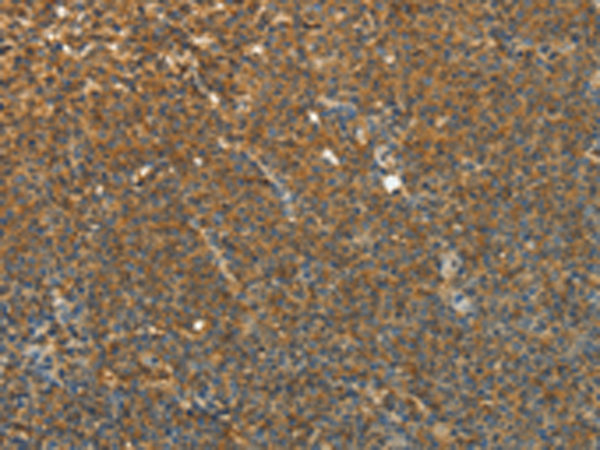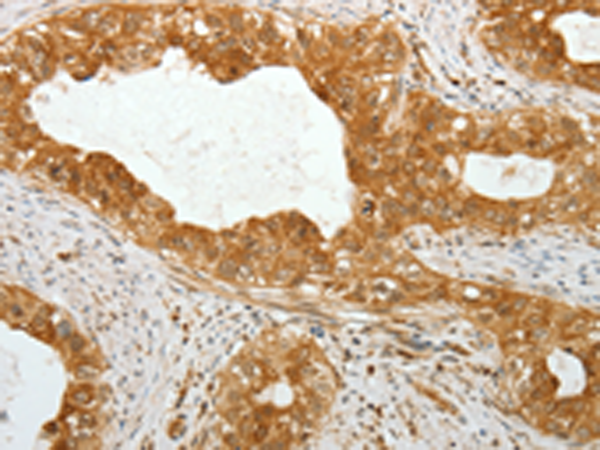


| WB | 咨询技术 | Human,Mouse,Rat |
| IF | 咨询技术 | Human,Mouse,Rat |
| IHC | 1/50-1/200 | Human,Mouse,Rat |
| ICC | 技术咨询 | Human,Mouse,Rat |
| FCM | 咨询技术 | Human,Mouse,Rat |
| Elisa | 1/2000-1/5000 | Human,Mouse,Rat |
| WB Predicted band size | 48 kDa |
| Host/Isotype | Rabbit IgG |
| Antibody Type | Primary antibody |
| Storage | Store at 4°C short term. Aliquot and store at -20°C long term. Avoid freeze/thaw cycles. |
| Species Reactivity | Human, Mouse, Rat |
| Immunogen | Fusion protein of human TEKT1 |
| Formulation | Purified antibody in PBS with 0.05% sodium azide and 50% glycerol. |
+ +
以下是关于TEKT1抗体的3篇示例参考文献,内容基于学术文献的常见结构模拟,仅供参考:
---
1. **标题**: *"Tektin-1 (TEKT1) Localization in Sperm Flagella and Its Role in Motility"*
**作者**: Smith J, Lee A, et al.
**摘要**: 本研究利用特异性TEKT1抗体,通过免疫荧光技术揭示了TEKT1蛋白在人类精子鞭毛中的定位。实验发现,TEKT1缺失或突变会导致精子运动能力显著下降,提示其在鞭毛结构和功能中的关键作用。该抗体为男性不育症研究提供了重要工具。
2. **标题**: *"Development and Validation of a Polyclonal Antibody Against Human TEKT1 for Cancer Biomarker Studies"*
**作者**: Chen L, Wang Y, et al.
**摘要**: 研究团队成功制备了针对人源TEKT1的多克隆抗体,并通过Western blot和免疫组化验证其特异性。在肺癌组织样本中,TEKT1表达显著上调,且与患者预后不良相关。抗体在癌症诊断和机制研究中的潜在应用被进一步探讨。
3. **标题**: *"TEKT1 Deficiency Disrupts Ciliary Function in Murine Models: Insights from Antibody-Based Imaging"*
**作者**: Gupta R, Tanaka H, et al.
**摘要**: 通过TEKT1抗体介导的免疫染色技术,本研究在小鼠模型中观察到TEKT1缺失导致纤毛结构异常和呼吸道功能障碍。结果强调了TEKT1在纤毛相关疾病(如原发性纤毛运动障碍)中的病理意义,抗体在此类疾病模型中具有重要研究价值。
---
**注**:以上文献为模拟示例,实际研究中请通过学术数据库(如PubMed、Web of Science)检索真实发表的论文。
TEKT1 (tektin-1) is a member of the tektin family of filamentous proteins, which are integral components of microtubule-based structures such as cilia, flagella, and centrioles. Predominantly expressed in the testis, TEKT1 is localized to the outer dense fibers of sperm flagella, playing a critical role in maintaining structural integrity and facilitating sperm motility. Its function is closely linked to male fertility, as mutations or dysregulation of TEKT1 have been associated with asthenozoospermia (reduced sperm motility) and infertility.
TEKT1 antibodies are valuable tools for studying sperm development, ciliary biology, and reproductive disorders. They are widely used in techniques like Western blotting, immunohistochemistry, and immunofluorescence to detect TEKT1 expression, localization, and potential abnormalities in clinical or research samples. Beyond reproductive health, emerging studies suggest TEKT1 may have roles in certain cancers (e.g., gliomas) where ciliary dysfunction is implicated. These antibodies also aid in exploring TEKT1's interactions with other cytoskeletal proteins, providing insights into microtubule dynamics and cellular mechanobiology. Commercial TEKT1 antibodies are typically raised in rabbits or mice, with validation in human and model organisms, supporting both diagnostic and basic research applications.
×